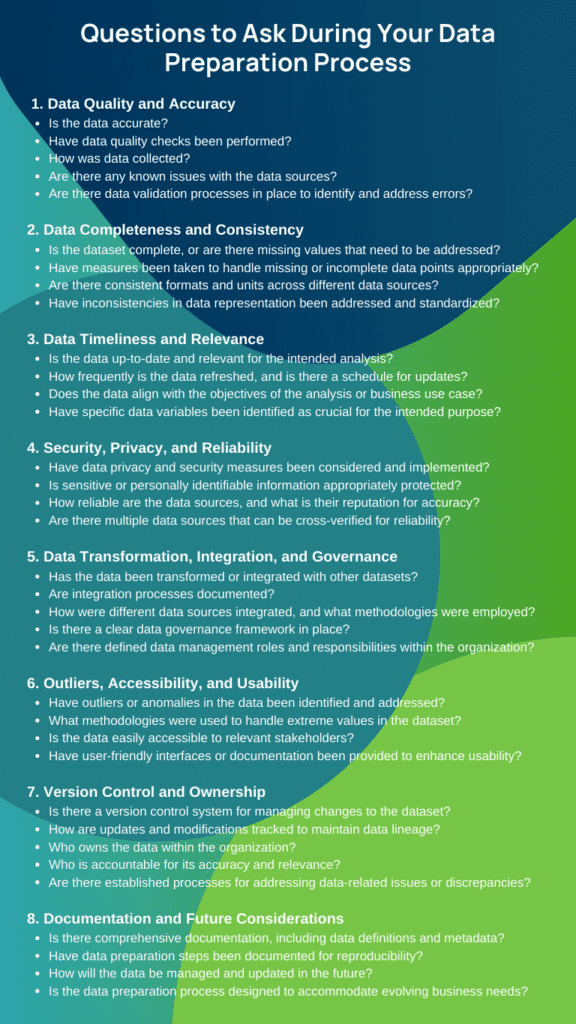
Data is key in modern business, but how do you prepare yours for growth and profitability? In this article, Vendavo experts Corey Schroeder, Bob Kuchler, Prasad Desai, Shynu Samuel, Nelson Normahomed, and Lehrasib Ali weigh in on everything from how to ensure quality in your dataset to what to keep in mind during cloud migrations and beyond.
Inflation, labor shortages, environmental regulations, market volatility, supply chain disruptions, and economic fluctuations are just some of the disruptions impacting organizations today.
Things change quickly, and we need to be able to adapt and change with them. You already know how key your data is to strategic decision-making.
But…
Do you know how to prepare your data – and your organization – for growth and profitability?
You need to be able to access, refine, and leverage your data so you can make smart business decisions. We’ve written before about some best practices to make this process as impactful as possible.
We asked several Vendavo subject matter experts about their top tips for preparing data for growth and profitability, and they had some excellent advice.
Here’s what they recommend to keep your data working on your behalf:
1. Always Start with a Foundation of Quality Data
Ensure your data is high quality, but without getting bogged down in perfection. A good place to start is to make your dataset manageable.
Focus on reducing data size, eliminating outliers using AI, and creating a strategic plan that identifies valuable components. Set expectations with stakeholders regarding potential issues and define acceptable levels of accuracy.

Corey Schroeder
Vice President of Product Management at Vendavo
“Good data is critical, but perfection can create problems. If the data has been good enough for previous projects or manual reviews, it’s time to determine if and why it requires improvement. Focus on the value and strategically improve where it matters.”
Making your data manageable will make it easier to maintain quality. This will also prevent you from wasting time focused on perfection (which doesn’t add value).
2. Create Guidelines for Data Readiness
Data readiness guidelines help with daily operations like:
- informed decision-making
- risk mitigation
- optimizing resource allocation
- strategic planning and forecasting
- performance measurement
- identifying customer insights
- market segmentation
- continuous operational improvement
- building stakeholder confidence
To set yours, begin by coordinating your processes and data structures. Give each data record a unique ID, then understand hierarchies for effective classification. Implement data drops at various project stages and be sure to emphasize the importance of quality data for different project phases.

Bob Kuchler
Senior Director of Data Integration at Vendavo
“Harmonization and understanding hierarchies are essential steps in ensuring data readiness at every stage of your project. You need to ask yourself, ‘What constitutes a customer?’ Then define that. Is that a sold-to? A payer? Does a ship-to belong to a specific customer? Is there an end customer? Is it possible to negotiate the price with an end customer without a sold-to customer? All these answers improve your data readiness guidelines.”
Creating data readiness guidelines or hierarchies makes everything run smoother, and that allows you to take a deeper look at your data.
3. Set Best Practices for Quality Data Insights
How your data is gathered, stored, and formatted matters. Capture relevant dimensions and numeric fields as a solid starting point for strategic decision-making. You also may not be able to access the data you need in the first place.
There are a few best practices for quality data insights that can’t be skipped:
Exclude data outliers and emphasize nuanced practices. Focus on clarity in data points to identify trends and take informed actions. Remember, your best practices will be unique to your organization and its overarching goals.

Prasad Desai
Value Consultant at Vendavo
“You need a foundation for data-driven growth, so you can capture the right dimensions and numeric fields for effective analyses. Having best practices certainly ensures that you are working with good-quality data and generates confidence in the insights resulting from any analyses.”
Taking the time to organize your data early will mean benefits like improved decisioning, efficiency, risk management, and overall performance later.
4. Identify Important Data Preparation Tips
The importance of data preparation can’t be understated. Preparing your data before taking on a massive project improves accuracy, quality, and completeness, leading to better integrations, analysis, and reporting down the road.
Effective data preparation starts with clearly understanding project data needs. Validate and clean your data at the source, address missing data promptly, and filter out any information that is not relevant or impactful for the project. Lastly, don’t be afraid to utilize a data dictionary for harmonization across multiple business units.

Shynu Samuel
Director of Solution Architecture at Vendavo
“Understand, validate, and clean data at the source for effective data preparation. A data dictionary can be helpful, too, so that your different business teams can understand what each data element means and why it’s relevant.”
The quality of your data determines the quality of your outcomes, so it’s best to ensure quality, accuracy, and usability as soon as possible.
5. Plan for Data Preparation in Cloud Migration
Cloud migration is important because it offers your organization benefits like cost efficiency, scalability, improved performance, better security, and access to advanced technologies. It also leads to improved data storage and usage, which in turn leads to better business outcomes.
There are some things to be mindful of when planning a cloud migration: Careful planning and continuous optimization are key to successful data preparation. It’s best to start by appointing a migration architect, then establish performance baselines to measure improvements both before and after the migration takes place. You should plan to prioritize migration components and perform any necessary refactoring, too.

Nelson Normahomed
Senior Director of Cloud Operations & IT at Vendavo
“In the realm of cloud migration, you need to identify whether you’re dealing with a simple ‘lift and shift’ or a deeper integration that leverages something bigger, like Cloud Services or AMS. This sets the stage for the rest of the project, so you need to identify the scope early.”
This process doesn’t end when the migration is complete, though. Keep data quality and formatting in mind. Your production phase should include a two-week “hypercare” engagement process to monitor and review both performance and resource utilization.
6. Optimize Cloud and IT Infrastructure for Data and Profitability
Migrating to the cloud is one thing, but you must optimize your infrastructure to maximize outcomes. Strike a balance between cost, performance, security, and availability when optimizing cloud and IT Infrastructure – particularly if you want to see sustained growth and profitability.
Transparency in costs, usage, and forecasts paints a clearer picture of cloud and IT infrastructure and resource utilization.

Nelson Normahomed
Senior Director of Cloud Operations & IT at Vendavo
“Striking a balance in cloud and IT Infrastructure is crucial for sustained growth and profitability. It’s about smart resource management and ensuring we don’t overspend on unused capacity. Infrastructure cost and utilization optimization requires continuous monitoring to maintain efficiency. It’s all about striking that right balance.”
Bonus tip: Effective governance involves key stakeholders from finance to executives. That’s because our understanding of cloud economics becomes increasingly important as cloud usage grows. You’ll need constant monitoring and optimization to keep infrastructure costs and utilization in check.
7. Achieve Success Through Solution Implementation Insights
Once your data is prepared for analysis and use, you need the right solutions in place to ensure you’re getting the most from it.
The solution you choose to help with your data for growth and profitability should fill one of two objectives: to improve processes, efficiency, and revenue, or to analyze and improve profitability trends. In either case, you should discuss, agree, and list out the key performance indicators (KPIs) that are important to measuring your growth and profitability. Be sure to agree on data sources, formats, and mapping to achieve those KPIs.

Lehrasib Ali
Principal Consultant at Vendavo
“Continuous iterative improvement is the key for ongoing success when it comes to data. You should constantly check and improve your data sources, data quality, and data analytics. This improves your reporting and trend tracking so all business decisions can be made with the best possible information.”
Quality only stays quality with constant monitoring and cleaning. An iterative data quality check process will help, ensuring you have the best data to work for meaningful analysis, better reporting, and improved decision-making and trend tracking.

Ready to Transform Your Data Strategy?
Vendavo is in business to help you reach and exceed your growth and profitability goals. Reach out today to speak with our experts about how we can help you revolutionize your data strategy for ongoing business success.
